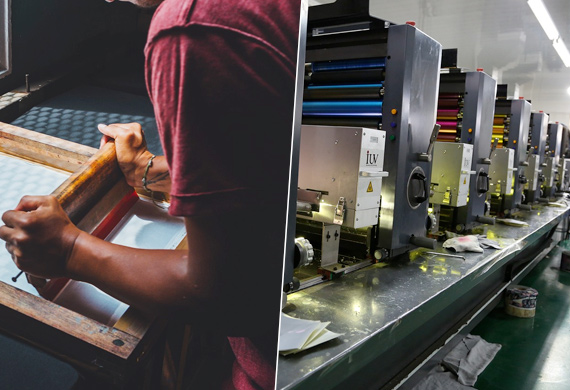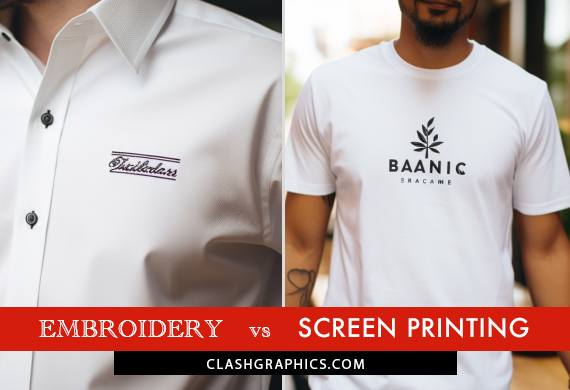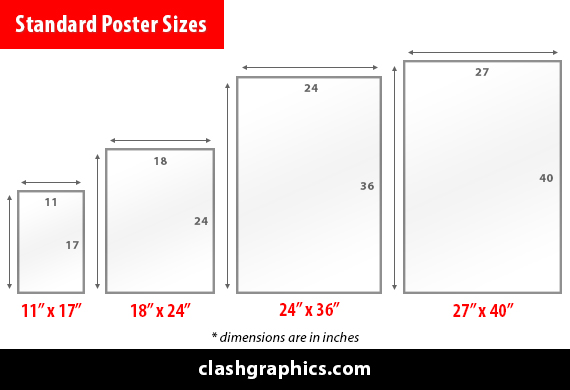Benefits of Screen Printing vs. Sublimation and Offset vs. Digital Printing
Posted by Clash Graphics on 18th Jun 2019
Avoid costly mistakes and delays when taking your design to print. Discover the printing techniques available for your project, their benefits, and disadvantages.

Knowing the basics of the four principle printing methods will help you make informed decisions to achieve the best results for your marketing materials or printed products.
clashgraphics.com explores screen printing vs. sublimation, and offset vs. digital, their differences, applications, and cost benefits.
Screen Printing vs. Sublimation
When you want to place your design, logo, or message on a t-shirt, coffee mug, mousepad, or other promotional materials, screen printing and sublimation are the options that may provide the best results. Here are the significant differences, applications, and benefits of each printing type:
Screen Printing Method
This method of printing involves the use of mesh stencils. One stencil for each color of a design is created by using ultraviolet light to harden a substance applied to the mesh that prevents the passage of ink. The rest of the substance is then washed away.
The washed away areas allow ink to be pushed through open holes in the mesh with a squeegee onto the garment or product, one color at a time.
This process creates a high level of vibrancy, even on dark shirts, as more ink is applied to the garment than in other printing methods.
Material - While screen printing can be used on nearly any material, it is best applied to flat surfaces and can produce high-quality images on:
• Shirts
• Sweatshirts and pants
• Workout Gear
• Backpacks
• Tote Bags
• Glass
• Flags
• Binders
• Ceramics
• Aprons
Advantage - This method is most efficient when:
• Large quantities of printed product are needed.
• The design is simple.
• Fewer colors are used.
• Printing on dark shirts and using bright colors.
Setup and Production - Screen printing setup is costly and time-consuming since one stencil must be made for each color of a design. Print shops will often require a minimum quantity for this printing method.
Disadvantage - Over time, printed images may crack, chip, fade or peel away from the product, especially when exposed to frequent washing or laundering.
Watch this video to see how screen printing is applied to paper.
Sublimation Method
Also referred to as dye sublimation, this method of printing uses sublimation ink digitally printed on sublimation paper, which is then transferred to a destination material through heat and pressure.
Temperatures ranging from 195 to 250 degrees and pressure cause the sublimation ink to convert from a solid state to a gaseous state, and the pores of the destination surface or material to open. The ink leaves the sublimation paper and permeates the surface of the destination material.
Once the heat is removed, the sublimation ink returns to a solid state and the pours of the material close around it. The image is infused with the surface of the destination material, whereas screen printing leaves an image layered onto the surface.
Material - Ideal results are achieved on 100% polyester and polyester blended garments or items with a polymer coating, on white or light-colored materials. There are plenty printable products, some of which include:
• Shirts
• Coffee Mugs
• Mouse Pads
• Ceramic Tiles
• Drink Coasters
• Christmas Ornaments
• Dog Tags
• Key Chains
• Clock Faces
• Lighters
• Umbrellas
As long as there is a receptive material for the sublimation ink, and uniform heating can be applied, this method produces outstanding results.
Advantage - This method is most advantageous when:
• Your design is detailed and has many saturated colors.
• Small quantities of printed product are needed.
• Using different designs on multiple items or material.
• You need a fade resistant design.
Setup and Production - Sublimation printing setup is costly, and product production is time-consuming. When compared to screen printing, the sublimation process produces more stunning and photorealistic results in a much easier way.
Disadvantage - Unlike screen printing, sublimation is limited to polyester-blended garments or items with a polymer coating.
Watch this video to see how sublimation printing is done on dark shirts.
Offset vs. Digital Printing
When you want to produce brochures, flyers, books, newsletters, posters, and other marketing material, your first step is to create your design, copy, and layout. Once this is done, decide between offset and digital printing (oftentimes unaware, and based on the printing company you use). Here are the significant differences, applications, and benefits of each printing type:
Offset Printing
Offset printing, also known as lithography, is the most common printing method for high volume commercial projects.
This method utilizes water, ink, rubber rolls, and metal plates (one plate is made for each color) which transfer ink to rubber rolls. As the paper moves through the rolls, color is layered on to produce the final image.
Material - Offset printing allows you to print on multiple media surfaces, which can include:
• Paper
• Card Stock
• Plastic
• Metal
And is most beneficial when used to mass produce:
• Posters
• Books
• Book Covers
• Brochures
• Business Cards
• Mailers
• Flyers
• Newsletters
• Newspapers
• Magazines
Advantage - This method is most efficient when:
• Large quantities of printed product are produced (over 500 pieces).
• An exact color match is required.
Setup and Production - Offset printing setup is costly and time-consuming due to the production of each plate used in the process. However, once the project has been set up, production time is fast with impressive color and quality.
Disadvantage - While offset printing has many advantages, the following should be taken into consideration:
• Rush jobs don’t happen with offset printing. Since the plates must be created, there is a longer timetable to consider.
• Low volume jobs will have a high price per piece.
• Typos and graphics errors can cause the loss of a batch and the need to start the process over from scratch.
Watch this video to see how offset printing works.
Digital Printing
Much like the inkjet or laser printer you may be using at home, print shops use ones that are larger, more precise, and much faster.
Digital printing eliminates the need for proofs, plates, and rubber rolls, printing your design directly to the printing surface with powdered toner or liquid ink.
Material - Digital printing allows you to print on multiple media surfaces, which can include:
• Paper
• Card Stock
• Plastic
Which may be used to produce smaller quantities of:
• Posters
• Book Covers
• Brochures
• Business Cards
• Mailers
• Flyers
• Newsletters
Advantage - This method is most beneficial when:
• Small quantities of printed product are needed.
• A faster turnaround time is required.
• Changes are needed in print (you can change dates and times on flyers or invitations within a single batch).
While the cost for digital printing is excellent in small quantities, keep in mind that the price for offset printing reduces as quantities increase. At some point, the cost-benefit between offset and digital will invert.
Setup and Production - Digital printing setup is fast and requires digital graphics rather than metal plates.
Disadvantage - While digital printing has many attractive advantages, the following disadvantages should be taken into consideration:
• While much progress has been made, digital print jobs cannot create exact color matches, where offset utilizes specially mixed inks and makes a closer match.
• The options of materials you can print on are significantly reduced.
• Digital printing quality and sharpness are slightly lower than that of offset printing.
• Large-volume jobs cost more.
Watch this video to see how a large format digital printer works.
Types of Printing for Your Project
Knowing the difference between screen printing and sublimation, and offset and digital will help you avoid costly mistakes and re-orders when taking your design to print?
In this article, you discovered the differences, applications, benefits, and disadvantages of screen printing vs. sublimation, and offset vs. digital printing.
Don’t allow the wrong type of printing technique to misrepresent your design, break your budget, or reduce the quality of your project. Use your knowledge of the four principle printing methods to make informed decisions, and achieve the best possible results.
Sources:
https://99designs.com/blog/tips/popular-printing-techniques-guide/
https://99designs.com/blog/tips/digital-vs-offset-printing/
http://scalar.usc.edu/works/packaging/sublimation-textile-printing-vs-digital-printing
http://sites.tech.uh.edu/digitalmedia/materials/3252/Printing_Unit.html
Clash Graphics Print Shop Atlanta Flyer Printing
2233 Peachtree Rd NE Ste 202 Atlanta, GA 30309
(678) 235-3464






